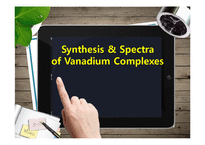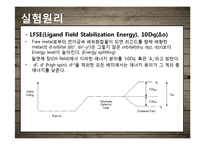2.실험원리
전이 금속 화합물의 bonding theory
10Dq에 영향을 미치는 요인
배위화합물의 전자스펙트럼
3.실험방법
Vanadium의 산화수와, 리간드가 다르게 vanadium complexes를 각각 합성해본 후 10Dq가 어떻게 달라지는지 결과를 해석한다.
10Dq의 의미와 Orgel Diagram에 대해서 이해한다.
직접 합성한 complex를 바탕으로 ligand spectro chemical series를 직접 구해본다.
실험원리
1. 전이 금속 화합물의 Bonding Theory
LFT ( Ligand Field Theory )
MO theory를 전이 금속에 적용시킨 이론으로써, CFT에서 고려하지 않았던 valence orbital까지 고려하여 bonding의 overlapping을 설명한다.
실제적인 Spectra 해석의 기본이 된다.
dx2-y2,dz2와의 궤도함수는 리간드들과 결합성 궤도함수를 이룰 수 있지만, dxy,dyz, dzx 궤도함수는 결합성 궤도함수를 이룰 수 없다.
금속의 4s,4pz.4py,4pz,3dx2-y2,3dz2 는 궤도함수들과 대칭성이 일치함으로 결합성 궤도함수(Bonding Orbital)를 이루며 dxy,dyz,dzx는 리간드와 상호작용을 하지 않고 비결합(nonbonding)상태로 남게 된다.
- LFSE(Ligand Field Stabilization Energy), 10Dq(Δo)
Free metal로부터 전이금속 배위화합물이 되면 리간드를 향해 배향한 metal의 d-orbital (dz2, dx2-y2)은 그렇지 않은 orbital(dxy, dyz, dzx)보다 Energy level이 높아진다. (Energy splitting)
팔면체 장(Oh field)에서 이러한 에너지 분리를 '10Dq' 혹은 'Δo‘라고 칭한다.
d0, d5 (high spin), d10을 제외한 모든 배치에서는 에너지 분리가 그 계의 총 에너지를 낮춘다.
2. 10Dq에 영향을 주는 요인
1) Transition metal의 산화수
Metal ion의 positive charge↑
→ Effective nuclear charge(ENC)↑
이온의 반지름↓
→ Metal-ligand 결합길이↓ → Orbital overlap↑
⇨ 10Dq 증가
2. 10Dq에 영향을 주는 요인
2) Ligand effect
➀ π-bonding effect : Metal의 d-orbital중
σ-bonding에 참여 하지 않은 dxy, dyz, dzx (t2g)와 리간드의 π-orbital(t2g)과 π-bonding한다.
π-donor Ligand ( L→M π-bonding )
: Ligand의 occupied π-orbital과 Metal의 HOMO(t2g)가 overlap
→complex의 HOMO energy level ↑
→ 10Dq 감소 (weak field Ligand)
π-accepter Ligand ( M→L π-back bonding )
: Ligand의 빈 π*-orbital과 Metal의 HOMO(t2g)가 overlap
→
HOMO energy level ↓
→ 10Dq 증가 (strong field Ligand)
Spectrochemical Series
: 10Dq 값을 측정하여 결정된 Complex의 Ligand Field 세기 서열
CN⁻ >NO2- >Phen >bipy >en >NH₃≳Py>H2O>OH⁻>F⁻>S2⁻>Cl⁻>Br⁻>I⁻
➁The Chelate effect
: 엔트로피의 증가로 인해 chelate ligand를 갖는 착물의 안정도가
chelate l igand를 갖지 않는 착물의 안정도보다 크다.
ex) Didentate ligand를 가진 화합물의 안정도는는 2개의 Monodentate ligand를 가진 화합물의 안정도보다 더 크다. 이렇게 열역학적으로 안정한 착물은 더 큰 LFSE를 갖고 10Dq가 증가한다.
Concepts and Model of Inorganic Chemistry by Douglas, D.
Inorganic chemistry by Huheey, J.
Advanced Inorganic chemistry By cotton
Wikipedia / http://www.wikipedia.com
Inorganic chemistry by Gray L. Missler, Donald A. Tarr























 분야
분야


